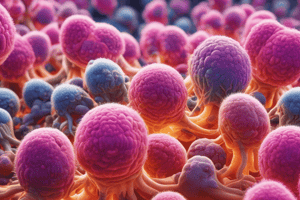Podcast
Questions and Answers
Which characteristic distinguishes Streptococcus pyogenes from other streptococcal bacteria?
Which characteristic distinguishes Streptococcus pyogenes from other streptococcal bacteria?
- Its beta-hemolytic activity, indicating complete lysis of red blood cells. (correct)
- Its ability to produce spores under adverse conditions.
- Its motility due to the presence of flagella.
- Its classification as a Gram-positive bacterium.
A patient presents with symptoms of pharyngitis, followed by a red, sandpaper-like rash. Which complication of the initial infection is most likely indicated by the rash?
A patient presents with symptoms of pharyngitis, followed by a red, sandpaper-like rash. Which complication of the initial infection is most likely indicated by the rash?
- Rheumatic heart disease.
- Scarlet fever. (correct)
- Acute glomerulonephritis.
- Necrotizing fasciitis.
What immunological process is most closely associated with the development of acute rheumatic fever following a Streptococcus pyogenes infection?
What immunological process is most closely associated with the development of acute rheumatic fever following a Streptococcus pyogenes infection?
- Exotoxin-mediated damage to the heart valves.
- Type II hypersensitivity reaction involving molecular mimicry. (correct)
- Deposition of immune complexes in the kidneys.
- Direct bacterial invasion of the heart tissue.
In a patient diagnosed with necrotizing fasciitis caused by Streptococcus pyogenes, what virulence factor is primarily responsible for the rapid tissue destruction?
In a patient diagnosed with necrotizing fasciitis caused by Streptococcus pyogenes, what virulence factor is primarily responsible for the rapid tissue destruction?
Following a bout of streptococcal pharyngitis, a child develops edema, hematuria, and hypertension. Which of the following pathological processes is most likely responsible for these clinical signs?
Following a bout of streptococcal pharyngitis, a child develops edema, hematuria, and hypertension. Which of the following pathological processes is most likely responsible for these clinical signs?
Flashcards
Streptococci
Streptococci
Non-motile, non-spore-forming, spherical bacteria.
Beta-hemolytic streptococci
Beta-hemolytic streptococci
Destroys red blood cells completely around colonies in culture.
S. pyogenes (Group A Streptococcus)
S. pyogenes (Group A Streptococcus)
A beta-hemolytic streptococcus; leading cause of strep throat.
Streptococcal Pharyngitis (Strep Throat)
Streptococcal Pharyngitis (Strep Throat)
Signup and view all the flashcards
Necrotizing Fasciitis
Necrotizing Fasciitis
Signup and view all the flashcards
Study Notes
- Streptococci are non-motile, non-spore-producing, spherical bacteria.
- They cause scarlet fever, rheumatic heart disease, glomerulonephritis, and pneumococcal pneumonia.
Group A Streptococcus
- Includes S. pyogenes, a beta-hemolytic streptococci, which completely destroys blood cells.
- It is a leading cause of:
- Streptococcal pharyngitis ("strep throat")
- Acute rheumatic fever
- Scarlet fever
- Acute glomerulonephritis
- Necrotizing fasciitis
- Can also cause:
- Sinusitis
- Otitis
- Joint or bone infections
- Meningitis
Studying That Suits You
Use AI to generate personalized quizzes and flashcards to suit your learning preferences.



